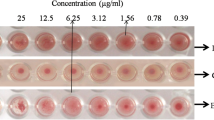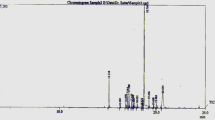Abstract
The anti-proliferative, cytotoxic and apoptotic activities of Swietenia mahagoni (L.) Jacq. leaf extract (SMLE) was investigated against Ehrlich’s ascites carcinoma (EAC) in mice. SMLE significantly inhibited the growth and the metabolic activity of viable EAC cells in a dose- and time-dependent manner as observed in both in vivo and in vitro studies and also showed characteristic features of apoptosis. Flow cytometric analysis showed appreciable number of cells in early and late apoptotic stages. Cell cycle analysis revealed that treatment with SMLE arrested the EAC cell populations in the G2-M phase of cell cycle. SMLE induced apoptosis is mediated through mitochondrial intrinsic pathway involving the release of cytochrome c into the cytosol and activation of caspase-9 and caspase-3. The two flavonoids, catechin and quercetin-3-O-glucoside isolated from Swietenia mahagoni (L.) Jacq. leaves, which have been found to be the active ingredients responsible for the anti-leukemic activity of SMLE, may be responsible for the activity of SMLE on EAC.






Similar content being viewed by others
References
Abdullaev FI (2001) Plant-derived agents against cancer. In: Gupta SK (ed) Pharmacology and therapeutics in the new millennium. Narosa Publishing House, New Delhi, pp 345–354
Abdullaev FI, Luna RR, Roitenburd BV, Espinosa AJ (2000) Pattern of childhood cancer mortality in Mexico. Arch Med Res 31:526–531
Andreani A, Scapini G, Galatulas I, Bossa R (1983) Potential antitumor agents. IX synthesis and antitumor activity of two analogues of ketocaine. J Pharm Sci 72:814–815
Balunas MJ, Kinghorn AD (2005) Drug discovery from medicinal plants. Life Sci 78:431–441
Budihardjo I, Oliver H, Lutter M, Luo X, Wang X (1999) Biochemical pathways of caspase activation during apoptosis. Ann Rev Cell Dev Biol 15:269–290
Cao Z, Li Y (2002) Chemical induction of cellular antioxidants affords marked protection against oxidative injury in vascular smooth muscle cells. Biochem Biophys Res Commun 292:50–57
Chatterjee SN, Agarwal S (1988) Liposomes as membrane model for study of lipid peroxidation. Free Radic Biol Med 4:51–72
Darzynkiewicz Z, Bedner E, Smolewski P (2001) Flow cytometry in analysis of cell cycle and apoptosis. Semin Hematol 38:179–193
DeFeudis FV, Papadopoulos V, Drieu K (2003) Ginkgo biloba extracts and cancer: a research area in its infancy. Fund Clin Pharmacol 17:405–417
Earnshaw WC, Martins LM, Kaufmann SH (1999) Mammalian caspases: structure, activation, substrates, and functions during apoptosis. Ann Rev Biochem 68:383–424
Engel RH, Evens AM (2006) Oxidative stress and apoptosis: a new treatment paradigm in cancer. Front Biosci 11:300–312
Gallego MA, Ballot C, Kluza J, Hajji N, Martoriati A, Castéra L, Cuevas C, Formstecher P, Joseph B, Kroemer G, Bailly C, Marchetti P (2008) Overcoming chemoresistance of non-small cell lung carcinoma through restoration of an AIF-dependent apoptotic pathway. Oncogene 27:1981–1992
Hoagland HC (1982) Hematological complications of cancer chemotherapy. Semin Oncol 9:95–102
Li P, Nijhawan D, Budihardjo, Srinivasula SM, Ahmad M, Alnemri ES, Wang X (1997) Cytochrome c and dATP-dependent formation of Apaf-1/caspase-9 complex initiates an apoptotic protease cascade. Cell 91:479–489
Liu X, Kim CN, Yang J, Jemmerson R, Wang X (1996) Induction of apoptotic program in cell-free extracts: requirement for dATP and cytochrome c. Cell 86:147–157
Martin SJ, Reutelingsperger CP, McGahon AJ, Rader JA, van Schie RC, LaFace DM, Green DR (1995) Early redistribution of plasma membrane phosphatidylserine is a general feature of apoptosis regardless of the initiating stimulus: inhibition by overexpression of Bcl-2 and Abl. J Exp Med 182:1545–1556
Mishell BB, Shiigi SM, Henry C, Chan EL, North J et al (1980) Preparation of mouse cell suspensions. In: Mishell BB, Shiigi SM (eds) Selected methods in cellular immunology 23. W.H.Freeman & Co, San Francisco, pp 21–22
Pal S, Choudhuri T, Chattopadhyay S, Bhattacharya A, Datta GK, Das T, Sa G (2001) Mechanisms of curcumin-induced apoptosis of Ehrlich’s Ascites carcinoma cells. Biochem Biophys Res Commun 288:658–665
Pryor WA (1973) Free radical reactions and their importance in biochemical systems. Fed Proc 32:1862–1869
Shi Y (2001) A structural view of mitochondria-mediated apoptosis. Nat Struct Biol 8:394–401
Sur P, Chatterjee SP, Roy P, Sur B (1995) 5-Nitrofuran derivatives of fatty acid hydrazides induce differentiation in human myeloid leukemic cell lines. Cancer Lett 94:27–32
Takeoka GR, Dao LT (2003) Antioxidant constituent of almond [Prunus dulcis (Mill.) D.A. Webb.] hulls. J Agric Food Chem 51:496–501
Wising C, Azem J, Zetterberg M, Svensson LA, Ahlman K, Lagergard T (2005) Induction of apoptosiss/necrosis in various human cell lineage by Haemophilus ducreyi cytolethal distending toxin. Toxicon 45:767–776
Yang J, Liu X, Bhalla K, Kim CN, Ibrado AM, Cai J, Peng TI, Jones DP, Wang X (1997) Prevention of apoptosis by Bcl-2: release of cytochrome c from mitochondria blocked. Science 275:1129–1132
Acknowledgments
The work was funded by University Grants Commission, India under Minor Research Project Scheme.
Author information
Authors and Affiliations
Corresponding author
Rights and permissions
About this article
Cite this article
Roy, S., Banerjee, B. & Vedasiromoni, J.R. Anti-tumor activity of Swietenia mahagoni (L.) Jacq. leaf extract against Ehrlich’s ascites carcinoma in mice. Orient Pharm Exp Med 13, 205–216 (2013). https://doi.org/10.1007/s13596-013-0123-5
Received:
Accepted:
Published:
Issue Date:
DOI: https://doi.org/10.1007/s13596-013-0123-5




